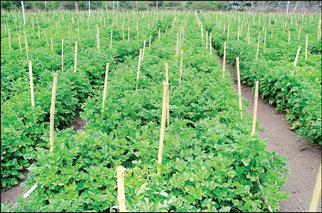Variety
How the potato grew in popularityP:
From a humble tuber to one of the world's main food crops
Here are more facts, some not so well-known, about this very popular
item in our day-to-day meals. The potato which is one of the most
popular vegetables worldwide and one of the world's main food crops
today, was long ago, a humble tuber growing in the valleys, high up in
the Andes mountains in South America. It was cultivated long before the
Incas established their kingdom. It is a vegetable that has a history of
about 800 years.

 The
potato is a tuber. The swollen end of an underground stem is called a
stolen. Tubers grow from this stolen, usually about six or seven,
sometimes as many as 20. What we call potatoes and eat are these tubers. The
potato is a tuber. The swollen end of an underground stem is called a
stolen. Tubers grow from this stolen, usually about six or seven,
sometimes as many as 20. What we call potatoes and eat are these tubers.
How did this tuber become one of the world's main food crops? Rice is
the staple food of more than half the world's population. Maize comes
second.
The potato is a close rival for second place.
The Spaniards who came to S. America in 1520, a little after the
Portuguese came to Sri Lanka, found the potato being cultivated in the
Andes valleys facing the Pacific coast. It was a food crop in the region
extending from present day Chile to Ecuador. They, the Spa, brought the
potato across the Atlantic to Europe, probably about 1550. Others
followed.
John Hawkins, a slave trader is said to have brought it to Ireland in
1565. Walter Raleigh, soldier, explorer and favourite of Queen Elizabeth
I brought the potato to England in 1586. Francis Drake introduced the
potato to France and the Netherlands and soon after, this new comer was
found in the gardens of the aristocracy in Germany.
There are interesting anecdotes about the early efforts to cultivate
this foreign plant. Here is one such anecdote. Thomas Heriot, a
mathematician, planted some seed potato on his estate in Ireland. The
plants bore small berries which the mathematician tried to eat. He found
them inedible (not fit to be eaten). Disappointed and angry he ordered
his gardener to uproot the plants.
It was then that the tubers growing under the soil were discovered.
(The cultivated plants don't bear berries like those growing in their
native lands).
Here is another. When the potato was introduced into Germany, it was
grown only in the gardens of the aristocracy. The ordinary farmers were
not interested in this foreign plant. King Fredrick the Great resorted
to a trick to make farmers grow potatoes. He had the royal estates
guarded by soldiers. The farmers thinking that this must be a very
valuable plant, slipped into His Majesty's fields in the night and stole
plants for their own farms.
 Today
Germany is one of the largest consumers of potato and Germany produces
6% of the world's total production. Russia is the largest producer.
Nearly 1/3 of the world's potato is produced in Russia, other large
producers are Poland, China and India. Today
Germany is one of the largest consumers of potato and Germany produces
6% of the world's total production. Russia is the largest producer.
Nearly 1/3 of the world's potato is produced in Russia, other large
producers are Poland, China and India.
When the Dutch Spaniards, British and Germans began to extend their
empires into Asia, Africa, America, Australia in the 18th and 19th
centuries, they introduced the potato to their new colonies.
In countries where the soil and climate were suitable, as in India,
potato cultivation spread rapidly.
By the end of the 17th century, the potato was the major crop in
Ireland, from then on until mid 19th century it was the staple food of
the majority in Ireland. Then in 1846 and 1847 potato crops failed due
to a blight (plant disease).
There was a great famine. People had nothing to eat for they were not
growing any cereal. This potato famine in Ireland is one of the major
disasters recorded in history. People who could afford migrated to
America.
This story recounts the opposite of what happened in Ireland. Early
in 2006, there was a great shortage of rice in Bangladesh, due to the
great floods the previous year. The Government asked the people to eat
potatoes. It was not a proposal like the advice Queen Marie Antoinette
gave the French peasants, when they complained that they had no bread to
eat. "If there is no bread eat cake", she said.

Potato is cultivated on a large-scale in Bangladesh. The year before
the rice shortage, the potato harvest had been 7 million tonnes. So
there was sense in the Government asking the people to eat potato as
there was no rice.
As you must be knowing Bangladesh was part of India until the
partition in 1947. The British who ruled India from the late 18th
century encouraged the cultivation of potato and exported it to their
colonies like Ceylon.
We continued to import potatoes from India until 1961 or 1962. Now
potato is grown in the Nuwara Eliya and Badulla districts, Welimada is
one place where potato is cultivated on a large-scale.
Although potato is generally called 'ala' in Sinhala, it has a
special name - arthapal, to distinguish it from other yams and tubers
like 'innala', 'kiriala'. Arthapal is from the Dutch 'aardappel'. So, it
must have been the Dutch who introduced the potato to our country and we
Lankans too called it by the Dutch name.
The Germans call it Kartoffel which means "apple of the earth".
Potato is from batala, a word closely related to the original name for
this tuber.
- Sumana Saparamadu |


